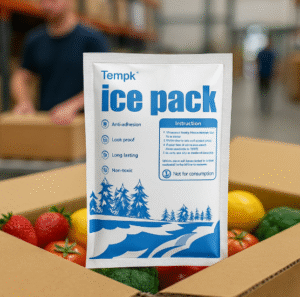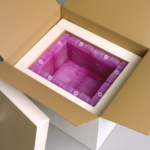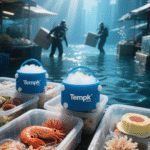What a “Paquet de glace sec” Is—and When Food Shippers Should Use It
Dry ice is solid CO₂ that sublimates (skips the liquid phase), staying near −78.5 °C at atmospheric pressure. That deep‑freeze profile makes it ideal for glace, frozen meats/seafood, bakery desserts, and any SKU that must remain ≤ −18 °C end‑to‑end. Because it turns into gas, there’s no meltwater to soak cartons—just be sure the box vents.
From a planning standpoint, dry ice absorbs roughly 25–27 kJ/mol when it sublimes—about ~571 kJ/kg, a handy number for estimating hold time and mass.

Quick Decision Matrix: Dry Ice vs. Gel vs. PCM (Nourriture)
| Scenario | Target Temp | Best Choice | Why it wins |
|---|---|---|---|
| Ice cream to homes, 24–72 h | ≤ −18 °C | Packs de glace sec | Deep‑freeze, long hold; label + vent required. |
| Meal kits / produce, 1–2 days | 0–8 °C | Packs de gel | Holds “refrigerated” range without freezing. |
| Frozen but not ultra‑cold (many foods) | −20 °C band | −20 °C PCM or dry ice | PCMs avoid CO₂ hazards + hazmat paperwork; test your lane. |
Tip: For mixed‑temp boxes, isolate zones—dry ice above the frozen portion, gel packs around the chill portion.
The 10‑Minute Pack‑and‑Label SOP (2025)
-
Pre‑condition
Pre‑freeze product; pre‑chill the shipper to cut initial heat load. -
Choose a vent‑capable shipper
EPS/EPP/VIP or validated corrugated‑foam sets. Never make it airtight; pressure from CO₂ gas must escape. (Required by 49 CFR §173.217.) -
Load & isolate
Line the box; keep food bagged and separated from dry ice surfaces. Top‑load blocks for stability; use pellets to fill side voids. -
Close, but keep venting
Secure flaps/tape seams without sealing every possible leak path; confirm a gas‑escape path. (49 CFR + IATA.) -
Apply marks & labels (air/ground couriers)
On the outer package, add:
-
UN 1845
-
Proper shipping name: Dry Ice ou Carbon dioxide, solid
-
Net mass of dry ice (kg)
-
Class 9 hazard label
Follow IATA PI 954 + operator acceptance checklist (2025).
-
Air waybill (when no Shipper’s Declaration is required)
If dry ice only cools non‑dangerous goods, enter this in AWB “Nature and Quantity of Goods”:
(Format per IATA + carrier job aids; FedEx example below.)
-
Tender & track
Ship early in the week; add a data logger on new lanes.
USPS (U.S. mail) is different: domestic air mail ≤ 5 lb (2.27 kg) per mailpiece and requires a Shipper’s Declaration affixed to the outside; international mail with dry ice is prohibited.
The Sizing Math (Rapide)
Energy method (good starting point):
-
Sublimation energy: ~571 kJ/kg
-
Dry ice needed (kg) ≈ Total heat load (kJ) ÷ 571
-
Total heat load = Heat gain (kJ/h) × transit hours
-
Ajouter 20–30% buffer for delays/heat waves.
Rule‑of‑thumb for food shippers (first trial):
| Hold Time | Small shipper (8–12 qt) | Medium shipper (20–30 qt) |
|---|---|---|
| 24 h | 2.3–3.6 kg (5–8 lb) | 3.6–5.4 kg (8–12 lb) |
| 48 h | 4.5–6.8 kg (10–15 lb) | 6.8–9.1 kg (15–20 lb) |
| 72 h | 6.8–11.3 kg (15–25 lb) | 9.1–13.6 kg (20–30 lb) |
These bands reflect common CDC/EHS guidance to budget ~5–10 lb per 24 h and should be tuned by your insulation, box size, and route temps.
Copy‑paste calculator (any notebook):
Safety You Can Audit
-
EPP: Insulated gloves + eye protection; dry ice is ~−78.5 °C.
-
CO₂ exposure: OSHA PEL 5,000 ppm (8 h TWA); STEL 30,000 ppm—ventilate pack‑out rooms, véhicules, and receiving areas.
-
Gas volume: 1 lb dry ice → ~250 L CO₂; small rooms can reach hazardous levels quickly.
-
Never airtight: Vent required by 49 CFR; IATA PI 954 addresses mark/label/documentation for air.
Receiving routine (food ops): Crack the box in a ventilated area, remove product, and allow remaining dry ice to dissipate—do not put in sinks/bins with sealing lids.
Carrier & Rule Highlights (2025)
| Rule set / Operator | Core requirement you’ll actually use | Why it matters |
|---|---|---|
| IATA PI 954 + 2025 Acceptance Checklist | UN 1845 + proper shipping name + net kg + Class 9; AWB text when no Declaration is required; operators use checklists. | Universal air‑cargo baseline; reduces acceptance failures. |
| 49 CFR §173.217 (U.S.) | Packages must secouer; specific markings; vehicle/containers marked appropriately. | Legal in the U.S.; prevents pressure incidents. |
| USPS 9A (U.S. mail) | Air mail ≤ 5 lb glace carbonique; address‑side text + Class 9; Shipper’s Declaration required (air). | USPS is stricter than couriers; avoid rejections. |
| FedEx | AWB line: UN 1845, Dry Ice, _ x _ kg; no DG Declaration if cooling non‑DG only. |
Copy‑ready wording; smooths intake. |
| UPS | “How to ship dry ice” mirrors PI 954; plan 5–10 lb per 24 h as a rule‑of‑thumb. | Practical mass planning + compliance pointers. |
Passenger baggage context (not cargo): many airlines allow ≤ 2.5 kg per person in carry‑on/checked bag for perishables if vented and marked—don’t confuse with cargo limits.
2025 Changes & What’s New
-
IATA DGR 66th Ed.: Acceptance checklist for dry ice is live; check operator variations and provide net weight during booking when requested (aircraft limits).
-
OMS (Edition 7, 2025): Updated Guidelines for the international packaging and shipping of vaccines—good patterns for venting, documentation, and handling if you ship food + health products together.
Copy‑Ready Labels & AWB Text
On the box (near the Class 9 label):
(IATA PI 954 + 49 CFR basics.)
On the air waybill (courants; when Declaration not required):
(FedEx job aid format.)
USPS air mail (domestic): add required Shipper’s Declaration, ≤ 5 lb per mailpiece, and mandated address‑side markings.
FAQ (Food Shippers)
How much dry ice for 48 h?
Typiquement 10–20 lb depending on insulation, shipper volume, and summer heat. Start with the table above and tune from logger results.
Is dry ice safe for food shipments?
Yes—if food is wrapped and pas in direct contact; ventilate and handle with PPE. (CO₂ PEL 5,000 ppm; STEL 30,000 ppm.)
Will my package explode if sealed?
Airtight packages can rupture as CO₂ builds. Regulations require venting for exactly this reason.
What’s the max dry ice per package by air?
IATA practice allows up to 200 kg per package under PI 954 (far above typical parcel weights); always check operator variations.
If I only need 0–8 °C?
Utiliser packs de gel—they hold refrigerator temps without freezing chocolate/produce.






















